The Kribensis Cichlid is a freshwater fish that is native to Africa. It is a popular fish for aquariums because of its bright colors and interesting behaviors. They require specific care requirements to thrive in an aquarium environment.
This guide will teach you everything you need to know about caring for a Kribensis Cichlid in your home aquarium.
So, without further ado, let’s get started!
Table of Contents
- Kribensis Cichlid: Species Summary
- Kribensis Cichlid: Food & Diet
- Kribensis Cichlid: Care
- Kribensis Cichlid: Tank Size
- Kribensis Cichlid: Water Parameters
- Kribensis Cichlid: Water Type
- Kribensis Cichlid: Water Changes
- Filtration
- Heater
- Lighting
- Setting Up Of Tank
- Cleaning The Tank
- Kribensis Cichlid: Common Possible Diseases
- Kribensis Cichlid: Treatment & Medications
- Kribensis Cichlid: Tank Mates
- Kribensis Cichlid: Fish To Avoid
- Advantages Of Having Kribensis Cichlid In Your Tank
- Disadvantages Of Having Kribensis Cichlid In Your Tank
- Conclusion
Kribensis Cichlid: Species Summary
| Scientific name: | Pelvicachromis pulcher |
| Common name: | Kribensis Cichlid, Purple cichlid, Palette cichlid, Rainbow krib, Pink kribensis cichlid, King cichlid |
| Size: | 3 – 4 inches |
| pH range: | 5.5 – 8.0 |
| Temperature range: | 73° – 80° Fahrenheit |
| Tank size (minimum): | 20 gallons |
| Feeding: | Omnivorous |
| Breeding: | Egglayer |
| Life Span: | 4 – 8 years |
| Compatibility: | Generally peaceful, can be territorial with other cichlids |
| Water Hardness: | 5 – 15 dGH |
| Water Type: | Freshwater |
| Nature: | Active, playful |
| Care Level: | Easy |
| Origin: | Africa |
With the right level of care, a Kribensis Cichlid can make a great addition to any freshwater aquarium. Let’s consider what you need to know to care for this fish.
Kribensis Cichlid: Appearance
The Kribensis Cichlid is a brightly-colored fish in various colors, including red, blue, yellow, and green. This fish typically has a black stripe that runs from the tip of its nose to the base of its tail. You might also see some black markings on the fins.
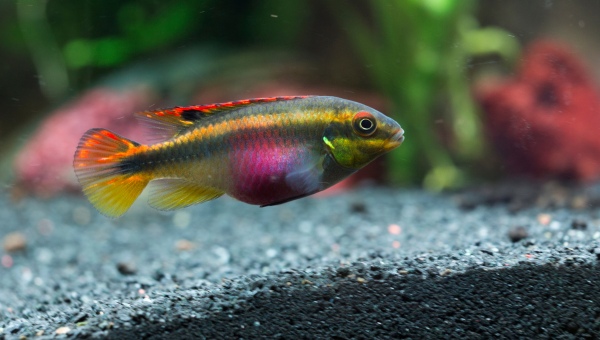
The most identifying feature of female Kribensis Cichlids is their bright orange-red ovipositor, which is used for laying eggs. Male Kribensis Cichlids typically have a more subdued coloration, and their fins are often edged in black. Also, males have long and pointed fins.
Long pelvic fins are another identifying characteristic of them. These fins are used for steering and stability while swimming. Overall, there’s a lot of variety in the appearance of these fish, so you’re sure to find one that catches your eye.
They are very active and playful fish and are often one of the most popular choices for home aquariums.
Kribensis Cichlid: Size
The Kribensis Cichlid is size around 4 inches in length for males and 3 inches for females and typically has a growth rate of about 1 inch per year. This fish is considered a medium-sized cichlid and will do well in a tank with a minimum size of 20 gallons.
Kribensis Cichlid: Lifespan
The lifespan of a Kribensis Cichlid is typically 4 to 8 years but can vary depending on the care and conditions of the aquarium. Like any other fish in the aquarium trade, they can be susceptible to various diseases and health issues. If you notice any signs of illness or distress in your fish, you must take action immediately.
While they might be relatively easy to care for, they require essential maintenance. In this section, we will go over the basics of caring for these fish.
Kribensis Cichlid: Behavior & Temperament
Kribensis Cichlids are very active and social fish, and they thrive when kept in a community tank. They are typically peaceful fish but can be territorial towards their own kind. In the aquarium, they will often form pairs or small groups.
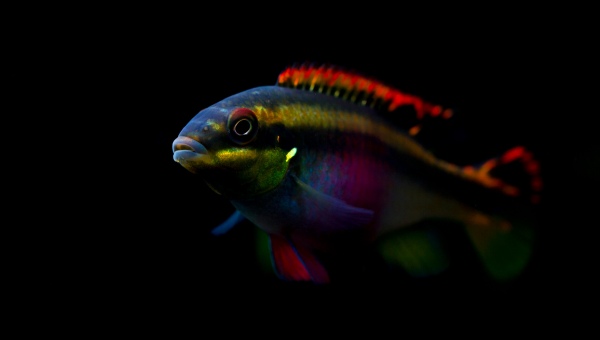
They make great pets for both beginners and experienced aquarists.
When choosing a Kribensis Cichlid, it is essential to consider its temperament. Some fish may be more aggressive than others, and others may be better suited for a community tank. It is also essential to consider the size of the tank. They can grow up to 4 inches long, so that you will need a tank with at least 20 gallons of water.
You might also encounter different behaviors in different strains of Kribensis Cichlids. They should not be kept with other fish that are not very nice or have a long, sharp, spiny dorsal fin, such as the Oscars.
Kribensis Cichlid: Breeding
Breeding Kribensis Cichlids is a straightforward process, and most fish will breed without assistance. They typically spawn in cave-like structures, so provide one for the female to lay eggs inside it. The female will clean the area to make extra space and deposit her eggs in the cave. And the male will guard outside the cave while the female will guard inside the cave.
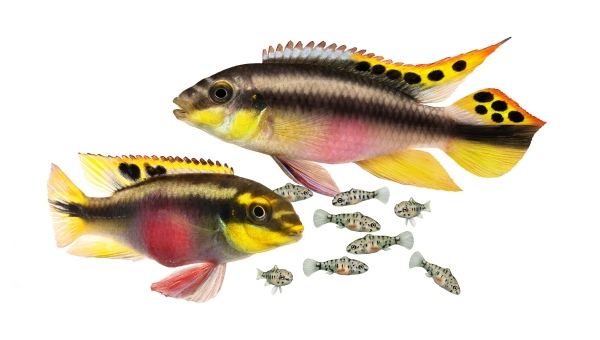
The eggs will hatch in about three days, and the fry can swim independently a few days later. The fry can be fed baby brine shrimp or other small fish food.
The fry can be moved to a separate tank when they become free-swimming. The parents will continue watching over the fry until they can survive independently.
Providing plenty of hiding places for the fry is essential, as they are vulnerable to predators.
If you are interested in breeding them, providing a tank of at least 30 gallons is essential. You will also need to provide a lot of plants and other hiding places for the fry.
Kribensis Cichlid: Food & Diet
Natural omnivores are not too fussy when it comes to food. In the wild, they feed primarily on small aquatic invertebrates, but in the aquarium, they will accept most types of food.
We recommend feeding your Kribensis Cichlid a diet that consists of the following:
- Live or frozen brine shrimp
- Live or frozen bloodworms
- Pellet food
- Tubifex worms
- Earthworms
- Mosquito larvae
- Small fish
You can also feed them various vegetable matter, including blanched spinach, zucchini, and cucumber.
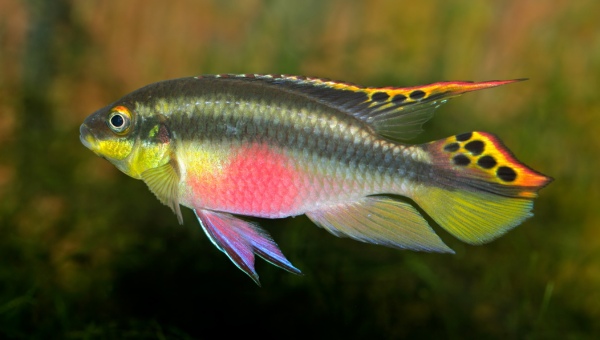
It is important to remember that overfeeding can lead to health problems in your fish, so be sure only to feed them what they can eat in a few minutes.
Kribensis Cichlid: Diet Foods To Avoid
There are some foods that you should avoid feeding your Kribensis Cichlid.
These foods include:
- Raw or cooked beef heart
- Raw or cooked chicken
- Raw or cooked shrimp
- Raw or cooked crab
- Raw or cooked fish
These foods can cause health problems in your fish, so it is essential to avoid them.
Kribensis Cichlid: Care
The Kribensis Cichlid care is considered easy, making it a good choice for beginner aquarists. These fish tolerate various water conditions and can adapt to various tank setups.
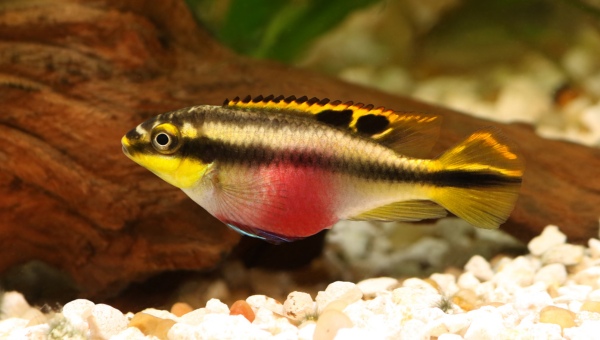
Whether you’re a seasoned aquarist or just starting, these fish are an excellent choice for any freshwater aquarium. Stick to the following care guidelines to ensure your Kribensis Cichlid thrives in your tank.
Kribensis Cichlid: Tank Size
As we mentioned, they can do well in a tank with a minimum size of 20 gallons. Larger tanks are even better, providing more space for the fish to swim and explore. If you’re keeping multiple fish in your aquarium, allow for enough space per fish.
They grow to a maximum size of 4 inches, so keep that in mind when choosing a tank.
Kribensis Cichlid: Water Parameters
They can tolerate a pH range of 5.5 to 8.0 and a temperature of 73° to 80° Fahrenheit. However, it is best to keep the pH between 6.8 to 7.4 and the water temperature at 77° Fahrenheit for optimal health.
You must also provide a moderate water hardness level, between 5 to 15 dGH. If your water is too soft or hard, add a water conditioner to adjust the levels.
Kribensis Cichlid: Water Type
They do best in freshwater aquariums but can also be kept in brackish water (a mix of salt and freshwater). If you keep your fish in salty water, use a marine salt mix and adjust the water parameters accordingly.
Often, they are found in the wild, living in blackwater habitats. If you want to replicate their natural habitat, consider adding peat moss to your aquarium. This will help to soften the water and create a more acidic environment.
Kribensis Cichlid: Water Changes
It is essential to perform water changes regularly to ensure your fish’s tank is healthy. We recommend changing 20 to 25% of the water every week.
Filtration
The Kribensis Cichlid is a reasonably hardy fish that can tolerate various water conditions. However, it is essential to use a good-quality filter to keep the tank healthy. A filtration system will help to remove harmful toxins from the water and keep your fish healthy.
We recommend using a filter with a flow rate of at least 200 gallons per hour.
Some of the best filters for aquariums include:
- HOB filters (hang-on-back): These filters are easy to use and are an excellent choice for beginner aquarists. They hang on the back of the tank and circulate the water using an air pump.
- Canister filters: Canister filters are more potent than HOB filters and can be used for tanks up to 500 gallons.
- Under gravel filters: Under gravel filters are a popular choice for large aquariums. They sit on the bottom of the tank and circulate the water using an air pump.
Heater
The Kribensis Cichlid does best when the water temperature is between 73° to 80° Fahrenheit. If your home’s temperature falls below this range, you must use a heater to keep the tank warm.
We recommend using a submersible heater with a thermostat to help maintain the desired temperature.
Some of the best heaters for aquariums include:
- Aquarium Heater: This is adjustable and can be used for tanks up to 300 gallons.
- Marine Submersible Heater: This heater is designed for saltwater aquariums and has a thermostat to help maintain the desired temperature.
Lighting
The Kribensis Cichlid does not need a lot of light and can tolerate low-light conditions. However, providing some light in the aquarium is still a good idea. This will help to keep the tank healthy and promote plant growth.
We recommend using a LED light or fluorescent light for your aquarium.
Some famous LED lights for aquariums are:
- Aqua illumination LED Lights: These lights are available in various colors and can be used for tanks up to 500 gallons.
- Marineland LED Strip Light: This light is an excellent option for beginner aquarists and can be used for tanks up to 30 gallons.
Setting Up Of Tank
There are a couple of things that you need to do to set up the rest of their tank.
- A water pump is necessary to circulate the water in the aquarium and help keep the fish healthy. We recommend using a pump with a flow rate of at least 200 gallons per hour.
- Food is essential for keeping your fish healthy and happy. We recommend feeding your Kribensis Cichlid a diet of pellet and flake food.
- A tank decor is a great way to add excitement to your aquarium. We recommend using rocks, plants, and driftwood to create a natural habitat for your fish.
- Caves are one of the most important decorations for a Kribensis Cichlid tank. These fish love to hide and use caves to escape predators and other fish.
Some good options include:
- Marimo moss balls: These balls are made of algae and make a great addition to any aquarium.
- Driftwood: Driftwood is a natural product perfect for adding a touch of nature to your aquarium.
- Plastic plants: Plastic plants are an excellent option for beginner aquarists and are safe for fish and other aquatic animals.
Cleaning The Tank
It is essential to clean your tank regularly to keep it healthy. We recommend cleaning the tank every week.
There are a few things that you need to do to clean the tank:
- Remove any uneaten food from the aquarium.
- Remove any algae from the tank walls and substrate.
- Remove any waste from the bottom of the tank.
- Rinse all of the decorations in the tank with cool water.
- Replace any dirty water with fresh water.
- Test the pH level and ammonia levels of the tank water.
- Add a dechlorinator to the tank if necessary.
- Start the pump and let the tank run for a few hours to circulate the water.
These are some of the basic steps that you need to take to clean your aquarium.
Kribensis Cichlid: Common Possible Diseases
The Kribensis Cichlid is a hardy fish and is not prone to many diseases.
However, there are some common diseases that you should be aware of.
- Ich: It is a protozoan parasite ciliate that can cause white spots on the fish’s body. This disease can be treated with medications.
- Fin rot: It is a bacterial infection that can cause the fins of the fish to become red and inflamed. This disease can be treated with antibiotics.
- Ammonia poisoning: It is caused by high ammonia levels in the water. This can be treated by removing the fish from the tank and adding a chemical to the water to neutralize the ammonia.
- Dropsy: It is a bacterial infection that can cause the fish to swell up and develop a lump on their body. This disease is often fatal, and there is no cure.
If you notice your Kribensi Cichlid displaying any of these symptoms, we recommend seeking medical attention from a qualified aquarist.
Kribensis Cichlid: Treatment & Medications
The best way to treat diseases in them is with medication. There are various medications available that can treat various diseases.
We recommend talking to your veterinarian about the best way to treat diseases in your Kribensis Cichlid.
Some common medications used to treat diseases in fish include:
- Aqua-Ick: Aqua-Ick is a medication used to treat ich.
- Aqua-Cure: Aqua-Cure is a medication used to treat fin rot and other bacterial infections.
- Maracyn: Maracyn is a medication for ammonia poisoning, ich, and other bacterial infections.
- Melafix: Melafix is a medication used to treat bacterial infections and wounds.
- Pimafix: Pimafix is a medication used to treat fungal infections.
The most common way to prevent diseases in them is to maintain a healthy aquarium. This can be done by following basic tank cleaning instructions and regularly testing the water.
Kribensis Cichlid: Tank Mates
Many different species of fish can be kept with Kribensis cichlids.
Some of the most famous tank mates include:
- Other types of cichlids: Many different types of cichlids can be kept with them. Some of the most popular cichlids include angelfish and discus.
- Barbs: These fish are active and are a great community tank addition.
- Danios: These fish are also active and can be kept in schools.
- Gouramis: Gouramis are peaceful fish that can be kept with other peaceful fish.
- Rainbowfish: Rainbowfish are beautiful fish that add color to the aquarium.
- Tetras: Tetras are small, peaceful fish that are a great addition to a community tank.
- Guppies: These fish are hardy and can tolerate a wide range of water conditions.
- Mollies: Mollies are also hardy and can be kept in fresh and salt water.
- Platies: These fish are also hardy and can tolerate a wide range of water conditions.
- Whiptail catfish: These fish are peaceful and make a great addition to a community tank.
- Zebra danios: These fish are active and colorful, and they make a great addition to a community tank.
When choosing tank mates for your Kribensis Cichlid, ensuring that all fish can live comfortably in the same tank is essential.
Kribensis Cichlid: Fish To Avoid
- Oscars: Oscars are predatory fish that can be aggressive towards other fish.
- Red Devils: Red Devils are predatory fish that can be aggressive toward other fish.
- Plecostomus: Plecostomus is a type of catfish that can grow very large, and they may eat the food meant for the Kribensis Cichlid.
It is essential to avoid aggressive fish with long, sharp, spiny dorsal fins.
So, as you can see, many different types of fish can be kept with them. It is essential to consider the tank’s size, the fish’s temperament, and the water conditions they can tolerate.
Advantages Of Having Kribensis Cichlid In Your Tank
- The first advantage is that they are straightforward to breed. They will often spawn without any assistance from you.
- The second advantage is that they are very peaceful fish. They will not attack other fish in the tank, and they can be kept with a wide variety of fish.
- Also, they are very hardy fish and can tolerate a wide range of water conditions.
- They are beautiful fish and add color to the tank.
- They are very active fish and make a great addition to a community tank.
- At last, they are inexpensive to purchase and can be found at most pet stores.
So, as you can see, there are many advantages to keeping them in your tank.
Disadvantages Of Having Kribensis Cichlid In Your Tank
The only disadvantage of keeping Kribensis Cichlids in your tank is that they can be messy. They will produce a lot of waste, and you must clean the tank frequently to keep the water quality high.
Also, they may eat the food meant for other fish in the tank.
So, while they do have some disadvantages, they are still great fish to keep in your tank.
Conclusion
So, whether you are interested in breeding Kribensis Cichlids or want to add beautiful fish to your tank, they are a great choice. They are easy to keep and tolerate a wide range of water conditions. They are also very peaceful fish and can be kept with other fish. So, if you want a great fish to add to your tank, consider them.



